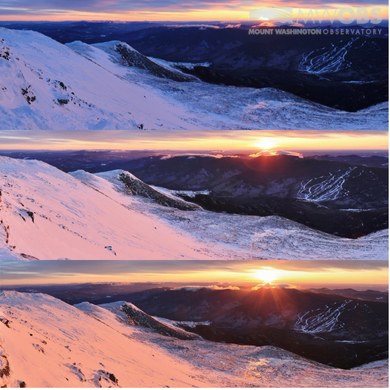The Return of Sunrise
2018-03-26 17:19:14.000 – Ryan Knapp, Weather Observer/Staff Meteorologist
Working nights on the summit, my shift typically starts at 1730 EST (1830EDT) and ends at 0530 EST (0630 EDT) the following morning. I don’t mind this shift, in fact, I prefer the night shift. However, it does have a few drawbacks, one of them being the lack of sunshine. This is especially true from late October through early March when the sun rises after my shift ends and sets before my shift begins again. During this time period, if I want to view a sunrise, sunset, or daylight in generally I have to either stay up after my shift ends or get up early prior to my shift beginning. The wait/wake time will vary anywhere from a few minutes to just over an hour. By the winter solstice, sunrise is at ~0710 EST and sunset is at ~1615 EST so that would mean I would have to stay up 1 hour 40 minutes after my shift ends for sunrise and wake up 1 hour 15 minutes prior to my shift beginning for sunset. By the end of my shift, I am typically exhausted, so I typically choose the early rise for sunset option. So this typically means I don’t get to view sunrise for roughly half of the year.
But then comes March and things start to flip towards my favor as sunrises start to occur earlier and earlier and sunsets start to occur later and later. By the summer solstice, sunrise is taking place at ~0355 EST (0455 EDT) and sunset is taking place at ~1940 EST (2040 EDT). So I get to enjoy a bit of sunshine at the start and end of my shift with the added benefit of seeing sunrise and sunset. Of course, this is assuming we get to see a sunrise or sunset to begin with. Over the course of the year, the summit is in the clouds (or fog when you’re up here in it) and this obscures a bulk of the sunrises and sunsets and other vistas we might get to see. So needless to say, I try to get out and view/enjoy any sunrise or sunset I can.
This shift marked my first summit sunrise of 2018 and it didn’t disappoint as I would give it a solid 6 out of 10. Anyone that has worked with me up here knows that I rank my sunrises/sunsets using a scale from 0 (fog) to 10 (spectacular). My sunrise/sunsets ranks are based on personal criteria and perspective and as such, my ranking will rarely if ever match another person’s rankings. But I always remind people that my ranking is based on over a decades worth of vistas to compare to. So someone seeing a sunrise up here for the first time, that might be their version of a 10 while I am throwing out that it was a 3; it’s all relative.
 Sunrise from the top of the Tuckerman Ravine Trail
Sunrise from the top of the Tuckerman Ravine Trail
So why a 6 for this first summit sunrise of 2018? Well a few reasons. There was a touch of undercast on the Carter-Moriah Range. Visibility was good albeit slightly hazy. There were clouds overhead, however, they resulted in little to no color due to their position in the sky. Some clouds in the distance near the horizon blocked or at least diffused the initial light, so the deep reds typical with alpenglow were lacking. Then as the sun rose above this cloud layer, some pinks and oranges eventually blushed the snowpack on the summit briefly prior to transitioning into the golden hour hues after the sun rose. With the fresh snow and rime, the pink and oranges were everywhere, so plenty of hues to view and all quickly changing in a span of 10 minutes prior to the light falling flat. Lastly, there were no added elements like showers, virga, a rainbow, etc to add something special and unique. So it all tallied to something just above average to me. All that being said though, I was still out and about enjoying this “6” of a sunrise, after all, it was my first for 2018. And if I had to rank it for my 2018 sunrises, it was a 10. But there are many more to come for 2018, so we will see where it ultimately ends up in my overall ranking later this year.
 Alpenglow – Timing Is Everything
Alpenglow – Timing Is Everything
Ryan Knapp, Weather Observer/Staff Meteorologist
 Alpenglow – Timing Is Everything
Alpenglow – Timing Is Everything



